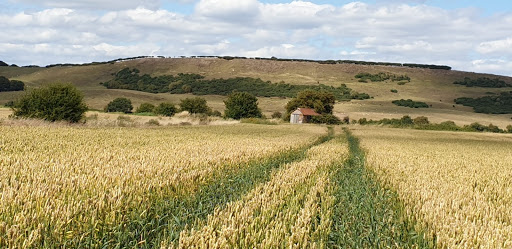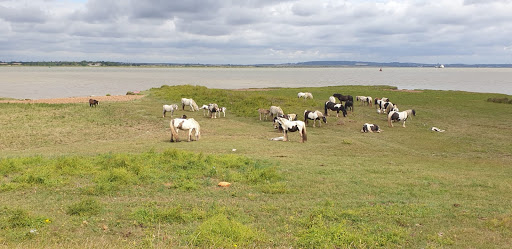Smugglers, literary inspiration, marsh frogs and seals in a bay of tranquility situated in the busy Thames Estuary
Lonely Egypt Bay is reached by a 3-mile walk along country
footpaths from High Halstow. You rarely see other people out here, just the
occasional walker or perhaps a local farmer out tending his animals. Yet barely
2 miles away on the other side of the estuary is the heavily industrialised south
coast of Essex where the huge D.P. World London Gateway container terminal & Canvey Island gas terminal are
situated. Massive container ships pass barely a mile offshore & the flight
paths of aircraft serving London City &
Southend airports pass overhead. Yet Egypt Bay remains an oasis of
tranquility surrounded by the turmoil of the modern world. It is a world of
wildfowl & waders which visit in large numbers to feed on the rich
estuarine mudflats. Common seals can often be seen fishing just offshore &
inland, the fleets & dykes are home to cackling marsh frogs, grass snakes,
& nesting warblers & waterfowl.
Birds of prey such as marsh harrier, short-eared owl &
kestrel hunt over the surrounding marshes. The area remains a stronghold of the
increasingly uncommon wall brown butterfly & the rare shrill carder
bumblebee.
There remains some mystery as to how this place got the
rather exotic name 'Egypt Bay' but the most likely explanation is its proximity
to local sites where Phoenician artefacts were discovered & the perceived
similarities of the small sandy beaches of Egypt Bay to the sands of the
Egyptian desert. The ancient Kingdom of Phoenicia was located where the modern
country of Lebanon is situated which is almost next door to Egypt & thus,
you arrive at the name, 'Egypt Bay'. The Phoenicians, who were at their zenith
between 1100 & 200 BC were renowned traders, seafarers & explorers.
They undoubtedly visited & traded in & around the Thames Estuary during
that period.
Charles Dickens, who lived a few miles away at Gad's Hill,
was known to have visited the area around Egypt Bay & is believed to have
perceived this place as the location of the prison hulk which the convict,
Magwitch, escaped from in Great Expectations. Cooling churchyard where he had
his encounter with 'Pip' is just 2 miles away. In reality no prison hulks were
ever moored in the vicinity of Egypt Bay. The nearest ones were located in the
Medway Estuary on the other side of the Hoo peninsula.

Sea lavender in
bloom at Egypt Bay.
The marshes just inland of Egypt Bay. Cliffe can be seen in the distance.

One of the fleets which present an attractive habitat to so
much wildlife.

The strange- looking 'Shade House is situated on the Halstow
marshes just to the south of Egypt Bay. It was originally a shepherds cottage
& gained notoriety as a hideout of the infamous 'North Kent Gang' which was
a group of smugglers who operated in this area during the 18thC. Around that
period the marshes here were malarial & life expectancy of the local residents
was only 30 years. Consequently, most people avoided the area & it was
extremely sparsely populated. This made it a very attractive haunt for
smugglers & they centred their activities in & around Egypt Bay. The
windows in the Shade House all face south, supposedly so that the inhabitants
would be readily alerted to any approaching excise officers ( the south being
the most likely direction they would come from).
There are unsubstantiated rumours of vaulted tunnels leading
from the house to Egypt Bay & other stories of how the smugglers would pay
local shepherds to drive their flocks down the tracks & paths frequently
used during smuggling activities so as to destroy any evidence of their presence.
The new Salt Fleet Flats Nature Reserve lies just about 100 metres to the west of Egypt Bay. It is part of a 'habitat compensation scheme to replace habitat lost on the opposite bank of the Thames Estuary during the construction of the D.P. World London Gateway container port at Stanford-le-Hope in Essex. The new reserve comprises 59 hectares of intertidal mudflats & 6 hectares of salt marsh. It was created by breaching a 700m long section of the existing sea wall after a new one, some 2 .4 km in length, had been built inland. This was the largest breach of a sea wall anywhere in the UK. The contractors worked closely with the RSPB to create the most favourable habitat for birds & collaborated with the Bumblebee Conservation Trust in developing a bespoke seed mix to be sown along the new sea wall to attract rare bumblebee species such as the shrill carder bee.
The area attracts large numbers of waders & wildfowl as well as a variety of other bird species such as yellow wagtail,pipits & finches which occur along the new sea wall. However, it should not be forgotten that a large area of fresh marsh , including several fleets & dykes which provided a valuable habitat for wildlife , was lost as a result of this project.

A number of these shallow pools which were created just
inland of the new sea wall are attractive to small wading birds such as ringed
plover, oyster catcher & green sandpiper.

The Thames foreshore just west of Salt Fleet Flats.

A Chinese container ship leaves London Gateway.






















